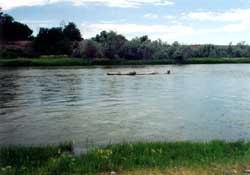|
The probable and logical place to
have crossed the Bighorn River seems to have been north of the
mouth of Kirby Creek. The diaries of Cornelius Hedges, Charles
Baker, William Atchison, William Haskell, and Howard Stanfield
all discuss in detail the crossing of the river on a ferry built
by Bridger's train and left to be used by those  trains
that followed. After coming down Kirby Creek and reaching the
Bighorn, none of the diaries speak of continuing downriver before
crossing. The trail diaries all indicate that Bridger immediately
crossed to the open west bank of the Big Horn. trains
that followed. After coming down Kirby Creek and reaching the
Bighorn, none of the diaries speak of continuing downriver before
crossing. The trail diaries all indicate that Bridger immediately
crossed to the open west bank of the Big Horn.
Upon reaching the river swollen by
spring runoff, Bridger's party constructed a raft or ferry. Stanfield
was in the train behind Bridger's, guided by John Jacobs. They
reached the river on June 7, and found "a small train calling
themselves the Independent [sic] consisting of ten wagons which
had arrived the day before and had been searching for the boat
ever since had found it buried in the sand on the opposite side
. . . took the Independents across and the next day come our turn
. . . Crossed the River today with 66 wagons 218 men 250 head
of stock in Eleven hours in a ferry boat built by Maj Bridger."
Took our departure from the ferry after burying the boat in the
sand and leaving notice of its whereabouts for the benefit of
the next train."
On June 11, the train led by Captain
Allensworth arrived at the river. Cornelius Hedges described the
day as "hot and sultry. . . . footed it to the river 6 miles,
good road--Wind river quite a stream. Boat built by Bridger's
train buried on other shore. . . . Lay down most of the day. .
. . towards night went to work on boat . . . putting over ox teams
till 1 o'clock." The next day, they were "up early.
. . . the ferry took over two wagons at a time. . . . quite a
time driving over horses and mules." On June 13, "After
burying the boat . . . [they] travelled . . . along river all
day."
Charles Baker's train reached the
river two weeks later. On June 29, they "traveled 16 mi.
. . . came to Big Horn River & camped." The next day,
he "crossed the Big Horn (Ferry $5.00) Hard work to get mules
& wagons across for all safely across & camped on the
West side." With the same train, Maynard recalled that "Bridgers
train had built a Boat of hewn logs large enough to carry one
Wagon . . . two men had left his [Bridger's] train and stayed
with the ferry boat to charge for the use of the ferry They asked
our train 5.00 per wagon some would not give the price but fond
[sic] down the river a mile where it was not so deep and some
forded." Atchison, too, wrote that he "laid over on
the banks of the 'Big Horn' awaiting a ferry. Crossed at 5:00
P.M. and camped on the opposite side of the river. Haskell's train
arrived at the river one week later on July 5. He "Drove
six miles and came to Wind River [Bighorn River]; found the old
train stopping there; laid by till nearly night, then run the
wagons on the ferry boat and crossed, swam the cattle."
When Major Owen and Bridger reached
the Bighorn River on October 9th, it was the time of year when
the river would be at its lowest possible average flow. All trains
arriving earlier in the season (June and early July) ferried across
the river due to high water and had some difficulty as indicated
by the diary entries above. Not so for Owen's party. There is
no mention of a ferry, and he matter-of-factly states that his
party crossed the river three times!
The train reached the river the night
of October 9, but Owen "remained back to bring up the rear
of the train & guard it against any Stragling [sic] Indians.
. . . [10th] found the train on B H River Crosd [sic] & Campd
[sic] in good grass. . . . [11th] followed down the Valley of
the Big Horn Crossed the river & camped road heavy Sand &
one bad rocky point to cross. . . . [12th] Late start repairing
. . . wagons traveld Some 4 Miles over a flat Crossd [sic] the
river & camped."
With the exception of Owen and Bridger's
train, the trains in 1864 followed the same course after crossing
the Bighorn River. They went forty-five miles down the west bank
of the Bighorn River to camp opposite the mouth of No Wood Creek
Creek which joins the Bighorn from the east. This is near the
present-day town of Manderson. From here the trail left the Bighorn
River and went northwest to the Greybull River.
|